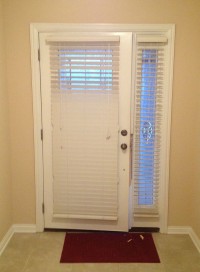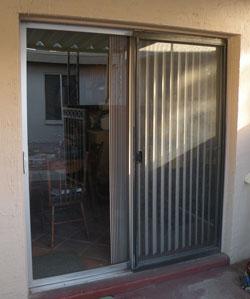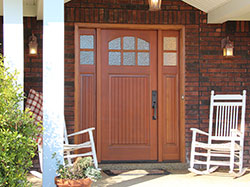Intentionally Inconsistent: Mixed Hardware Finishes
A recent customer approached us about her St. Matthews home. The home was built in the early 1930s and her recent renovation aimed to modernize it, while keeping the original aesthetic in place. A challenge? Not really.
There is no rule that says all hardware within a home must match. In fact, adding different finishes around the house, when done thoughtfully, can really add a new layer of design and interest within a home.
For this client, she was intentional not only about design, but also about her specific needs as related to both window and door hardware throughout the interior and exterior of the home.

Brushed nickel hardware on the window matches the stainless steel appliances in the kitchen.
With stainless steel appliances in the kitchen, she felt brushed nickel hardware worked best and maintained consistency throughout the room. In other parts of the house, darker hardware was used due to touches of dark accents in each room.

Oil-rubbed bonze is considered a “living finish.”
On her beautifully adorned brand-new back patio, she brought in the darker hardware with an oil-rubbed bronze. Oil-rubbed bronze is what’s known as a “living finish” which means it is uncoated with a sealant and will naturally oxidize over time to show a unique patina on the finish. It will transform slightly over time through exposure to the environment and regular use. Some refer to a living finish as a way for hardware to age gracefully, adding personality and charm to the doorknob over the years. This works in this beautiful space.

Dark bronze is sealed and perfect for doors in high-traffic areas.
For a more utilitarian approach, she selected a dark bronze doorknob for what is probably the door with the heaviest usage. Her side door is where she most enters the house from the car as she comes and goes throughout each day. For this reason, the dark bronze is the right fit as it is sealed and no patina or aging is expected. The color on a dark bronze piece of hardware will remain constant for years to come.
Finally, the question became what to do with the hardware on her front door. Original to the home, this brass doorknob really seemed to work. Our salesperson guided the homeowner to keep what “wasn’t broken” and continue using this ornate door knob which really serves as a jewel to the home – and it works with the design and in conjunction with the rest of the house. A nod to the past, this doorknob reminds all who enter that although this home is updated and current, it has a history which should be respected and enjoyed throughout all of its future generations.

The original brass doorknob adds character and charm to the home.
If you are considering updating the hardware throughout your home, consider adding different finishes to meet your needs and work with your design. Our designers can help guide you to select the right choices that will bring you happiness every time you enter a room!





 We’ve been called to at least five homes in the past 60 days due to a rash of break-ins involving kicked-in doors. In fact, the homeowners involved in this particular break-in were referred to us by the same police officer we had met earlier in the day at another job we were quoting.
We’ve been called to at least five homes in the past 60 days due to a rash of break-ins involving kicked-in doors. In fact, the homeowners involved in this particular break-in were referred to us by the same police officer we had met earlier in the day at another job we were quoting. which enables them to more easily compromise the lock hardware. Thin metal doors, like the builder grade products on this home, easily fold after just one or two kicks. Thicker metal doors are designed to withstand much more force. In addition, quality lock hardware should include a steel strikeplate installed with at least 3″ long screws to prevent fracturing of the wood door frame. This home had low grade lock hardware that yielded easily to forced entry (notice splintering of wood in frame between the door and sidelite).
which enables them to more easily compromise the lock hardware. Thin metal doors, like the builder grade products on this home, easily fold after just one or two kicks. Thicker metal doors are designed to withstand much more force. In addition, quality lock hardware should include a steel strikeplate installed with at least 3″ long screws to prevent fracturing of the wood door frame. This home had low grade lock hardware that yielded easily to forced entry (notice splintering of wood in frame between the door and sidelite). “The design of a sliding door requires the active, operable panel to have clearance at the top of the frame to allow for installation and for adjustment of the rollers. Proper roller adjustment allows smooth operation and prevents removal of the panel. Most sliding doors don’t receive adequate attention to keep the roller adjustment properly maintained and that makes the door susceptible to manipulation and forced entry.”
“The design of a sliding door requires the active, operable panel to have clearance at the top of the frame to allow for installation and for adjustment of the rollers. Proper roller adjustment allows smooth operation and prevents removal of the panel. Most sliding doors don’t receive adequate attention to keep the roller adjustment properly maintained and that makes the door susceptible to manipulation and forced entry.”





 Kentuckiana is our community! We’re locally-owned and operated, not a franchise, so you get attentive, local service.
Kentuckiana is our community! We’re locally-owned and operated, not a franchise, so you get attentive, local service.
